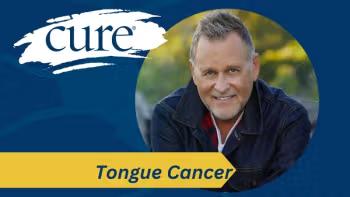
Expert Discusses The Future of EGFR+ and ALK+ Lung Cancer
There may be an upcoming shift in the treatment paradigm of patients with EGFR+ and ALK+ lung cancer.
Tagrisso (osimertinib), a third-generation EGFT inhibitor, has already shown potentially paradigm-shifting efficacy for patients with non-small cell lung cancer (NSCLC) who have the EGFR T790M mutation. Ongoing clinical trials are looking to determine the role of the therapy when combined with other agents.
The TATTON trial, preliminary results of which were presented at the 2015 ASCO Annual Meeting, is a phase 1b multi-arm trial exploring Tagrisso with two regimens: the MET inhibitor savolitinib or the MEK inhibitor selumetinib. Early findings showed that both regimens had good safety and were synergistic. Two partial responses (PRs) were reported with Tagrisso/savolitinib and two PRs with Tagrisso/selumetinib.
Secondly, an ongoing phase 1 study is looking at the safety and maximum-tolerated dose of the combination of Tagrisso and Portrazza (necitumumab) in patients with stage 4 or recurrent EGFR-positive NSCLC that has progressed on a prior EGFR tyrosine kinase inhibitor (TKI;
The addition of Tagrisso, potentially even in the frontline setting, poses even more sequencing questions for physicians as they decipher which EGFR TKI to administer to their patients first.
Please provide an overview of EGFR- and ALK- targeted therapies in NSCLC.
Christine M. Lovly, M..D, Ph.D., an assistant professor of medicine (hematology/oncology), assistant professor of cancer biology, medical oncologist, Vanderbilt-Ingram Cancer Center, discussed the changing treatment landscape for patients with EGFR-mutant and ALK-positive NSCLC during an interview with CURE.There are a lot of different targets in lung cancer right now. We focused on EGFR and ALK because we know the most about them. We talked about identifying EGFR and ALK and what to do when you find it. Now, more than 10 years after we found EGFR, we have multiple different drugs to treat patients with EGFR-positive lung cancer or with ALK-positive lung cancer. The question now is, “How do you sequence these drugs, and is there rationale for sequencing them?”
What should physicians know about the available EGFR TKIs?
This is a wonderful problem to have, because we have lots of options for our patients but we need to think critically about how we deliver the drugs in a specific sequence to optimize the effects we get against the tumor. There are three different classes of EGFR TKIs that we use now. There are the first-generation inhibitors Tarceva (erlotinib) or Iressa (gefitinib); those are the ones that we have had around the most and we have the most experience with. They are both FDA approved as frontline therapy for patients with metastatic EGFR-mutant NSCLC.
There is also Gilotrif (afatinib), which is a second-generation EGFR TKI. It is a little bit different than Tarceva and Iressa in that it’s an irreversible inhibitor. That is important to know because Gilotrif tends to have a little bit more toxicity — skin rash and diarrhea — than Tarceva or Iressa.
What are the next steps with these agents?
However, all those drugs were designed against wild-type EGFR. That is important because the newest class of EGFR inhibitors is the third-generation inhibitor Tagrisso. This was designed against the EGFR mutations, which we find in the lung cancer itself. That is important because those drugs tend to have better efficacy against the tumor with fewer side effects—less diarrhea and less rash than you see with the first- and second-generation inhibitors. There are lots of exciting directions for these therapies. We identify these mutations, and patients can be treated for years with different specific targeted therapies and now, especially with the evolution of these mutant selective inhibitors like Tagrisso, because they have less toxicity that also gives us potentially a greater therapeutic window to do combination therapies. One of the big things in the field right now is how to put drugs together with Tagrisso in rational combinations to make the good results we see with this drug even better.
Which of these combination strategies appear promising?
One big question is, “Should Tagrisso become the first-line therapy for patients with EGFR-mutant NSCLC?” It would replace Tarceva, Iressa and Gilotrif. There is an international phase 3 trial asking that question right now, and results should be reported probably within the next year. We will see what happens—whether we are going to completely change our paradigms or if we are going to sequence Tarceva, Iressa or Gilotrif followed by Tagrisso. There is an ongoing study called the TATTON trial looking at combinations of either Tagrisso with the MEK inhibitor selumetinib, or Tagrisso with the MET inhibitor savolitinib. Those are two rationally designed combination therapies. That study has been reported in abstract form, with some promising results seen with both regimens. We will see how those therapies continue to advance.
Regarding sequence, how do you currently determine which agent to give in each line of therapy?
There are also some clinical trials ongoing that are combining Tagrisso with EGFR-targeted antibodies and these studies follow suit to a study that was done with Gilotrif with cetuximab (Erbitux). This also goes with the thinking that we can use Tagrisso as it has less toxicity than some of the EGFR wild-type inhibitors to make combination therapy better. That is an exciting trial that is going on at multiple institutions right now combining EGFR inhibitors like Portrazza with Tagrisso. That is a very important question, but is very much a question in flux right now because we have multiple generations of inhibitors for both EGFR and ALK. The question is, “Should the most potent inhibitors come right away to the first treatment that patients get, or should you get the first- and second-generation drugs and then get the third-generation inhibitors? We have a lot of data right now showing that if you get a first-generation inhibitor, followed by a second or third-generation inhibitor, the progression-free survival on both of those is going to be months to years.
What other ongoing clinical trials are you excited about?
It will take systematic evaluation of clinical trials to determine the appropriate sequence, to establish efforts, and try to understand what resistance to any sort of line of therapy looks like. It is our job as physicians and scientists to always try to keep one step ahead of the tumor. Part of that is understanding the molecular basis for acquired drug resistance. We want to be able to tell our patients, “This drug is going to work for this long, then we are going to give you this therapy, and we have science behind that therapy that can explain why we think it is going to work.” This is the topic that is very near and dear to me, so with EGFR, I am excited to see all of these Tagrisso combination trials that are coming out. With the Tagrisso plus Portrazza trial and the TATTON trial, I am excited to see the basic science that is going to make rational combination therapies.
For ALK, there are several interesting trials going on right now comparing the different inhibitors. One thing that is particularly exciting in the field is that the National Cancer Institute is putting together an effort to make what they call an ALK Master Protocol trial. This is going to ask questions of how can we appropriately sequence these drugs — when we need a very strong community effort to be able to capture these patients — to answer these questions that we really want the answers to.
Patient advocacy [is also important] and we need to make this as much [about] teamwork as possible because these patients are incredibly knowledgeable and drive the field forward just as much, if not more, than any physicians or scientists do.




